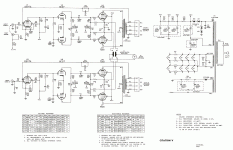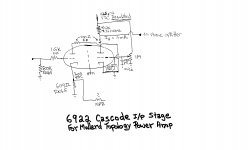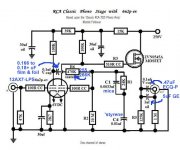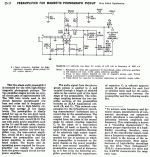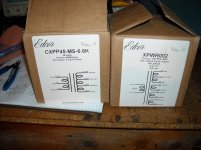Hi there.
After at least a half lifetime with silicon I have been more and more interested in valves aka. tubes.
My renovation of a pair of AR-3's will be ready this year and of course I wan't to hear them thru tube amps.
I do have a lot of iron but they are well varnished - not sure that I can take them apart but the idea of winding what I need surely grows some hair on my chest
 (and neck even if not so in demand
(and neck even if not so in demand  ).
).
Never mind - I have to pay for new iron if needed when I'm sure of what to buy.
I rather not buy a kit - I rather find a well behaved circuit with a group backing it willing to answer questions. My plan is to use p2p wiring with some "connector boards" to gather junctions. A question arises - what about different qualities of wire - needed insulation? Should I wirewrap to posts and then solder?
Safety - yes, very important. I have an old TV repair certificate so I've had my share of encounters with HV and live chassis. I also have read the safety thread here at diyaudio and agree that it is more or less sound.
What I want at this time of my journey:
I have the first parts of the chain and the last. L75's in different shapes and the AR-3's.
To start with I will also keep my Salas 63/~40db folded phono pre's. I will also start with keeping my hotrodded blue DCB1 as a buffer, volume control and input selector.
Today I use two refurbished Quad 303's as poweramps.
The design of tomorrow - as I don't have preamplification so I presume integrated is my way to go?. If worthwhile - why not a tube pre and split it to a pre and 2 monoblocks . I'm leaning towards using KT-88 as powertubes. If reasoned with I could as well use EL-34 or some of the 6V6 variants. I want 2 monoblocks delivering about 50W into 4ohms. The amps must have oomph to function down to 2 ohms for short periods as the AR-3's can be demanding.
. I'm leaning towards using KT-88 as powertubes. If reasoned with I could as well use EL-34 or some of the 6V6 variants. I want 2 monoblocks delivering about 50W into 4ohms. The amps must have oomph to function down to 2 ohms for short periods as the AR-3's can be demanding.
For the pre - no clue at this time.
As I do not have heard the sound of tubes in HIFI for a long time or actually maybe never - I'm a blank sheet - please fill it with some useful ideas
 .
.
Regards
After at least a half lifetime with silicon I have been more and more interested in valves aka. tubes.
My renovation of a pair of AR-3's will be ready this year and of course I wan't to hear them thru tube amps.
I do have a lot of iron but they are well varnished - not sure that I can take them apart but the idea of winding what I need surely grows some hair on my chest

Never mind - I have to pay for new iron if needed when I'm sure of what to buy.
I rather not buy a kit - I rather find a well behaved circuit with a group backing it willing to answer questions. My plan is to use p2p wiring with some "connector boards" to gather junctions. A question arises - what about different qualities of wire - needed insulation? Should I wirewrap to posts and then solder?
Safety - yes, very important. I have an old TV repair certificate so I've had my share of encounters with HV and live chassis. I also have read the safety thread here at diyaudio and agree that it is more or less sound.
What I want at this time of my journey:
I have the first parts of the chain and the last. L75's in different shapes and the AR-3's.
To start with I will also keep my Salas 63/~40db folded phono pre's. I will also start with keeping my hotrodded blue DCB1 as a buffer, volume control and input selector.
Today I use two refurbished Quad 303's as poweramps.
The design of tomorrow - as I don't have preamplification so I presume integrated is my way to go?. If worthwhile - why not a tube pre and split it to a pre and 2 monoblocks
For the pre - no clue at this time.
As I do not have heard the sound of tubes in HIFI for a long time or actually maybe never - I'm a blank sheet - please fill it with some useful ideas

Regards
Hi Turbon,
I think you are on the right track with a pair of KT88/6550A output tubes. 6L6GC's can just reach 50 wpc using one pair, so they will be replaced more often. 7581A's are a 35 watt variant of the 6L6GC that you could also use with the savings on heater current. If it were me, I would run with the KT88 tubes. The newer KT series aren't needed in my view and might be more expensive. Future support? EL34/6CA7 wouldn't be happy at 50 watts, but I like them for 35 watts of power from a pair.
Using a single pair of tubes in each channel is wise as far as I'm concerned. I think that sounds better too. Using a single preamp and pair of mono blocks keeps the weight down to easier levels to move. A preamplifier allows you to use a stereo volume control. Two separate controls might be okay to live with for a short time, but it gets old really fast. You can even get those nice volume controls motorized for remote control use.
-Chris
I think you are on the right track with a pair of KT88/6550A output tubes. 6L6GC's can just reach 50 wpc using one pair, so they will be replaced more often. 7581A's are a 35 watt variant of the 6L6GC that you could also use with the savings on heater current. If it were me, I would run with the KT88 tubes. The newer KT series aren't needed in my view and might be more expensive. Future support? EL34/6CA7 wouldn't be happy at 50 watts, but I like them for 35 watts of power from a pair.
Using a single pair of tubes in each channel is wise as far as I'm concerned. I think that sounds better too. Using a single preamp and pair of mono blocks keeps the weight down to easier levels to move. A preamplifier allows you to use a stereo volume control. Two separate controls might be okay to live with for a short time, but it gets old really fast. You can even get those nice volume controls motorized for remote control use.
-Chris
Instead of the regular audio types, you could also take a look at TV -sweep- valves.
Cheap and capable of much more current than KT88s and such. Would work well with current hungry speakers.
There are a lot of threads about these in this forum.
I myself have made a very compact 2x 50W using small EL36 'sweeps'. I like them a lot.
Cheap and capable of much more current than KT88s and such. Would work well with current hungry speakers.
There are a lot of threads about these in this forum.
I myself have made a very compact 2x 50W using small EL36 'sweeps'. I like them a lot.
Hi Turbon,
...
Using a single pair of tubes in each channel is wise as far as I'm concerned. I think that sounds better too. Using a single preamp and pair of mono blocks keeps the weight down to easier levels to move. A preamplifier allows you to use a stereo volume control. Two separate controls might be okay to live with for a short time, but it gets old really fast. You can even get those nice volume controls motorized for remote control use.
-Chris
Thank you Anatech.
Do you have any particular pre in mind or can I use my DCB1 to work the KT-88's? I presume a pre stage...
Regards
Instead of the regular audio types, you could also take a look at TV -sweep- valves.
Cheap and capable of much more current than KT88s and such. Would work well with current hungry speakers.
There are a lot of threads about these in this forum.
I myself have made a very compact 2x 50W using small EL36 'sweeps'. I like them a lot.
Thank you Parafeed. I will make a search on these both on the net and in the deep bin... Not sure if I unforeseemly throwed my stash of tubes away 20 years ago
Regards
I agree with the KT88 idea. Mullard style circuitry is a good performer that's relatively bullet resistant in the stability department. So I suggest Mullard style circuitry.
A superior implementation of Mullard Topology can be found in the Harman/Kardon Citation V. Notice the use of high gm small signal types, which provide resistance to GNFB induced slew limiting. The 12BY7 shown is getting scarce and (IMO) best reserved for existing equipment. I'm providing a 6922 cascode alternative.
The ability to safely use high grid to ground resistance values with pentodes and cascodes makes a passive control center practical. Your "preamp" is reduced to source selection and level control. Nothing comes free and a passive control center is not an exception. Short, LOW capacitance, cabling between the center and power amp(s) is essential.
A superior implementation of Mullard Topology can be found in the Harman/Kardon Citation V. Notice the use of high gm small signal types, which provide resistance to GNFB induced slew limiting. The 12BY7 shown is getting scarce and (IMO) best reserved for existing equipment. I'm providing a 6922 cascode alternative.
The ability to safely use high grid to ground resistance values with pentodes and cascodes makes a passive control center practical. Your "preamp" is reduced to source selection and level control. Nothing comes free and a passive control center is not an exception. Short, LOW capacitance, cabling between the center and power amp(s) is essential.
Attachments
Hi Eli,
Agreed. However, I would push for an active preamp that at least has a buffered output. Plus, a nice RIAA stage would be a nice option.
I like your 6922 idea. Not bad for a UHF TV tuner tube.
Hi Turbon,
From a noise aspect alone, the lower output impedance of an active preamp can't be understated.
-Chris
Agreed. However, I would push for an active preamp that at least has a buffered output. Plus, a nice RIAA stage would be a nice option.
I like your 6922 idea. Not bad for a UHF TV tuner tube.
Hi Turbon,
Depends on the sensitivity of the amplifier. Solid state or tube, doesn't matter if they are accurate. You have far more choices with the preamp than you would if you had a tube preamp (or "passive") for amplifiers.Do you have any particular pre in mind or can I use my DCB1 to work the KT-88's? I presume a pre stage...
From a noise aspect alone, the lower output impedance of an active preamp can't be understated.
-Chris
I would push for an active preamp that at least has a buffered output. Plus, a nice RIAA stage would be a nice option.
I'm not a big fan of passive control centers, if for no reason other than the cabling restrictions. However, the OP could cobble a passive center together quickly and (optionally) recycle the parts, later on, into an active circuitry project.
Speaking of phono sections, I've uploaded the tweaked RCA setup for consideration. As phono preamps go, it's a fairly easy build and works well.
Attachments
Hi Eli,
That's an interesting little circuit. I really like that you have used the 12AX7 for this. When I get a chance, I'll put one together. I'll be using more mainstream components though.
Thank you for posting that.
-Chris
Forget the "boutique" parts shown and pay close attention to the blue corrections. The original graphic was prepared by "Buzz", from a narrative I provided. "Buzz" loves "boutique" parts, but they really aren't needed.
The tweaks deal with weaknesses in the RCA original. Grid leak, AKA contact, bias in the 2nd gain block lightly loads the EQ network and improves bass extension. Credit Thorsten Lösch with that idea. The MOSFET source follower deals with the wretched drive capability of the 'X7 triode.
Contact Jeff Yourison for a solidly performing, cost effective, PSU.
Attachments
Quick question..... what kind of speakers are you driving and how big is your listening space?
The speakers are AR-3's and the room size is 32 sq meters. I only listen at moderate levels.
Regards
.... and here comes all the different little suggestions!
I would agree with the circuit given by Eli in his post #6, but my little deviation would be for an UL output stage to give a superior loudspeaker driving circuit - not straight pentodes. (Much background on the UL topology vs. pentode and triode is to be found on the internet, mostly sound analyses.)
Good luck there. Some of us who came from the era have long since gone on to s.s. amplifiers, but are still fond of the classic tube execution.
I would agree with the circuit given by Eli in his post #6, but my little deviation would be for an UL output stage to give a superior loudspeaker driving circuit - not straight pentodes. (Much background on the UL topology vs. pentode and triode is to be found on the internet, mostly sound analyses.)
Good luck there. Some of us who came from the era have long since gone on to s.s. amplifiers, but are still fond of the classic tube execution.
Johan,
I agree with the assessment that the H/K Cit. 5 is a starting point. Either UL mode for the "finals" or, if full pentode mode is retained, regulated g2 B+.
Another tweak is employing an ECC99 as the phase splitter, instead of the 6CG7. The ECC99 exhibits higher gm than the 6CG7 and will provide a bit more gain too, which should be good for KT88 "finals". Another phase splitter "refinement" is replacing the tail load resistor with a 10M45S constant current sink (CCS). Forced symmetry, via CCS tail loading, is very well established as being good.
I agree with the assessment that the H/K Cit. 5 is a starting point. Either UL mode for the "finals" or, if full pentode mode is retained, regulated g2 B+.
Another tweak is employing an ECC99 as the phase splitter, instead of the 6CG7. The ECC99 exhibits higher gm than the 6CG7 and will provide a bit more gain too, which should be good for KT88 "finals". Another phase splitter "refinement" is replacing the tail load resistor with a 10M45S constant current sink (CCS). Forced symmetry, via CCS tail loading, is very well established as being good.
In the H/K Cit. 5 schematic, R10 and R31 are the phase splitter tail load resistors. Those resistors are candidates for replacement by CCSes. Because of forced symmetry, the AC balance pots. are not needed. Sometimes, it is necessary to connect the CCSes to a small negative voltage, instead of signal ground. A small negative voltage "always" works.
Ultra-linear (UL) mode connects the screen grids to taps on the O/P trafo primary, instead of directly to a positive voltage. The technique is a form of local NFB that has been called partial triode.
IMO, a better O/P tube biasing arrangement is 4X individual trim pots. (1 pot./KT88). "Stand" each KT88 on a precision 10 ohm resistor, which provides a convenient "idle" current test point.
The H/K Cit. 2 schematic illustrates both UL taps and individual bias trim potentiometers. "Cloning" the Cit. 2 is not feasible, as appropriate O/P "iron" is extremely difficult to source.
Ultra-linear (UL) mode connects the screen grids to taps on the O/P trafo primary, instead of directly to a positive voltage. The technique is a form of local NFB that has been called partial triode.
IMO, a better O/P tube biasing arrangement is 4X individual trim pots. (1 pot./KT88). "Stand" each KT88 on a precision 10 ohm resistor, which provides a convenient "idle" current test point.
The H/K Cit. 2 schematic illustrates both UL taps and individual bias trim potentiometers. "Cloning" the Cit. 2 is not feasible, as appropriate O/P "iron" is extremely difficult to source.
Hey Turbon, good to see you posting.
I've been contemplating something similar with 6L6GCs. I don't see much difference between them and 7581s.
I'm inclined to follow the phase splitter with source follower FET drivers.
I've got Edcor iron already on hand.
The OPTs have UL windings which I plan on using, even though they don't show on the label.
I've been contemplating something similar with 6L6GCs. I don't see much difference between them and 7581s.
I'm inclined to follow the phase splitter with source follower FET drivers.
I've got Edcor iron already on hand.
The OPTs have UL windings which I plan on using, even though they don't show on the label.
Attachments
Last edited:
Hi TheGimp,
The 7581A is a 6L6GC with a 35 watt plate. Compare that to the 30 watt plate in the 6L6GC. Otherwise they are pretty similar. The 7581A can also be called a KT66. If you want, you could think of the 7581A as going part way to a KT88 while still having low heater current.
The difference between a 6LGC and 7581A in practical terms is longer tube life. They both have the same plate voltage maximums otherwise. A 7581A will withstand the abuse a Fender Twin series amplifier throw at it without hum or red plates. The same couldn't be said for many of the 6L6GC's out there, even though Fender designed that amp to use the 6L6GC.
-Chris
The 7581A is a 6L6GC with a 35 watt plate. Compare that to the 30 watt plate in the 6L6GC. Otherwise they are pretty similar. The 7581A can also be called a KT66. If you want, you could think of the 7581A as going part way to a KT88 while still having low heater current.
The difference between a 6LGC and 7581A in practical terms is longer tube life. They both have the same plate voltage maximums otherwise. A 7581A will withstand the abuse a Fender Twin series amplifier throw at it without hum or red plates. The same couldn't be said for many of the 6L6GC's out there, even though Fender designed that amp to use the 6L6GC.
-Chris
FWIW, I find the fact that an authoritative KT66 data sheet that shows a 30 W. plate dissipation as being absolute maximum, to be quite interesting. The 6L6GC is rated for 30 W. of plate dissipation design maximum.
- Status
- This old topic is closed. If you want to reopen this topic, contact a moderator using the "Report Post" button.
- Home
- Amplifiers
- Tubes / Valves
- Back to roots...
